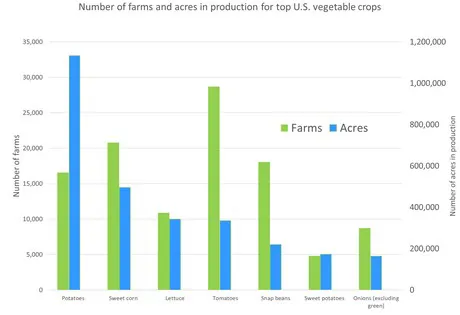The new Agriculture Census reports that there were roughly 74,000 farms growing vegetables in the US, which represents 4 percent of all US farms in 2017. Between 2012 and 2017 the number of farms increased by 3 percent. Across vegetable farms there were 4.4 million acres in production (visualize the land area of Connecticut and Rhode Island combined), representing just 0.4 percent of all agricultural acreage in the US. Total production acreage of vegetables decreased by about 3 percent since 2012 (that’s 126,000 acres lost).

Potatoes dominate vegetable production
So which vegetable dominates vegetable production? Potatoes account for a little over one-quarter of all US vegetable production acres (1.1 million) and 22% of all vegetable farms (or 16,554 farms). Not surprisingly, they also happen to be the most consumed vegetable by U.S. consumers. Potato acreage declined by 3% over the five year period, while the number of farms also decreased by 21%.
Sweet corn came in second in terms of total acreage in 2017 and was grown on almost 500,000 acres, followed by lettuce (including head, leaf, and romaine), tomatoes, snap beans, sweet potatoes, and non-green onions. The graph below shows the number of farms and acres in production in 2017 for these top acreage vegetable crops. (Also, now is a good time to tell you that I like charts and graphs, so expect more of these in my blogs.) Compared to 2012, the number of farms and acreage in production declined for sweet corn, snap beans, and tomatoes, but increased for lettuce and onions.
The top five crops in terms of farm numbers in 2017 were: tomatoes (28,673 farms), squash (22,704), sweet corn (20,784), summer squash (18,269), and snap beans (18,055).
Production of certain nutrient-dense vegetables has increased since 2012
The sweet potato (a relative of the morning glory, packed with vitamin A which supports vision and some evidence suggests it may be protective against some cancers) acres increased by 38% (or by 47,000 acres, roughly the size of Madison, Wisconsin) relative to 2012. Spinach acreage also rose from roughly 46,000 acres in 2012 to 70,000 acres in 2017, a 51% increase. Kale acreage, even though small in absolute terms, rose by 145% over the same time period. There were also substantial increases in acreage and production of ginseng, fresh cut herbs, mustard greens, and okra. Both acreage and number of farms producing Brussels sprouts went up over the same time period, too. All of this suggests growing demand for these products.
Some vegetable crops lost acreage compared to 2012, most notably (because of how substantial a decline they experienced) green peas, chili peppers, some peas (such as black-eyed and crowder), lima beans, and chicory. Interestingly, the number of farms producing these crops increased since 2012, suggesting that there is some restructuring of production happening for them. Why that’s happening is open to further inquiry.
Source: Union of concerned scientists
